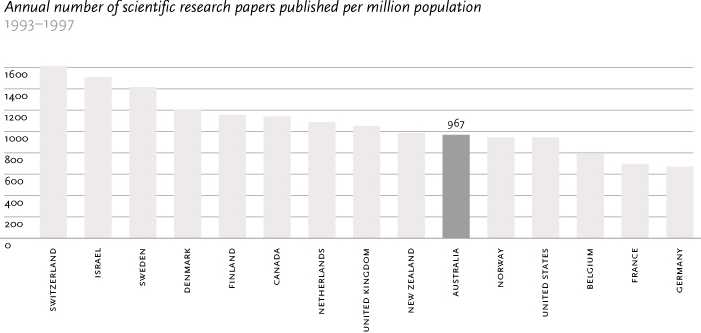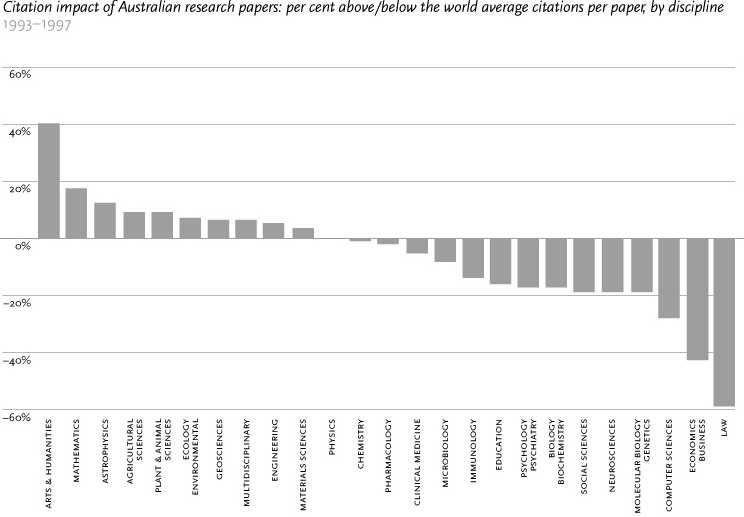![]() Australian Universities (Are/Are Not)
in Crisis -- Choose One. (September 28, 2001)
Australian Universities (Are/Are Not)
in Crisis -- Choose One. (September 28, 2001)
Just shy of a year ago the Senate referred to the Employment,
Workplace Relations, Small Business and Education References Committee the
inquiry into the capacity of public universities to meet Australia's higher
education needs. 362 submissions, 218 called witnesses giving over 1200 pages of
cross examined testimony during 14 hearing days nation-wide and six weeks
of report writing later what's the result? Well, if you think Anna Russell
had a point observing "You're exactly where you started 20 hours ago" when
abstracting Wagner's The Ring of the Nibelungs -- a year down the track
we're exactly where we started 12 months ago.
Aban
Contractor's summary in today's Sydney Morning Herald of the 460 page
report runs with Parties at loggerheads over uni standards. While
Misha Ketchell in the Age uses Students the victims of uni crisis,
report warns.
Benjamin Haslem in the Australian runs simply with Universities in
Crisis.
Education Minister David Kemp said the report served only to
run down the reputation of Australia's higher education institutions. He added
the choice of the title, Universities in Crisis, was a "grossly
irresponsible act... The universities are vibrant and thriving, and all the
Labor Party can offer is negative rhetoric that fails to recognise the enormous
achievements being made."
The report signed by the 3 Labor Senators and Democrat
leader Natasha Stott Despoja opens with, "This report reflects much of the
unease that has surrounded Australian universities in recent years. This unease
cannot continue to be dismissed by the Government as attributable to poor
management within the sector, or to the failure of universities to adjust to new
ways of thinking about their role in society. Growing isolation from national
decision-making, reduced funding and increasing student numbers have resulted in
universities experiencing deteriorating conditions of teaching and learning.
These developments pose a serious threat to the capacity of the higher education
sector to achieve the outcomes needed to sustain Australia's economic and social
development."
In addition Senator Stott Despoja in a 14 page supplementary report said, "To
describe our universities as being in 'crisis' is not a description that can or
has been made lightly. The Committee has read and heard compelling evidence that
the current Government's vigorous, indeed ideological, pursuit of marketisation
of education in combination with cutbacks in public funding have been the
principal factors resulting in our universities in crisis." She then lists 17
recommendations in addition to the 39 given in the majority report. It is
noteworthy that the "young ambitious leader of the Democrats" as Suzanne Cory,
Director of the Walter and Eliza Hall Institute has
referred to her is the only
member of the committee to make specific recommendations of allocation of
resources. Specifically, that at minimum, $500 million additional funds is
committed to university operating grants in 2002, as part of a 20% increase over
3 years to take account of unfunded changes in cost structures since 1996. That
this 3 year initial re-investment be the basis for a 10 year commitment that is
a more realistic basis for public investment in higher education. and
that additional funds of $10 million be allocated to the ARC for a "reflections"
program that gives academics grappling with fundamental conceptual issues in
their disciplines, notably the core sciences and humanities teaching relief to
enable and encourage considered reflection and speculation.
The 20 page report written by the two Government Senators takes strong issue
with the majority report, "At the outset, Government senators would like to
place on the record their disappointment and regret that the Opposition senators
have used the forum of this inquiry to sensationalise the challenges facing our
higher education sector and undermine the international reputation of our
universities and our community's confidence in their higher education
institutions, for cynical political purposes. The reluctance of Government
senators to support this inquiry at its inception rested entirely on the correct
assumption that this purpose would eventuate." They make no specific
recommendations in their report.
It appears most unlikely that the Howard Government will alter its view of
assigning our universities a low position in its list of priorities.
The full report in either MS-Word or PDF format is available on-line.
![]() Where Did the Web Come From and Who
Cares? (September 25, 2001)
Where Did the Web Come From and Who
Cares? (September 25, 2001)
It's gotten so that life before the World Wide Web is rapidly
fading into oblivion.
Where was it
originated and Why? Below is an excerpt from the particle physicist Gordon
Kane's popular book Supersymmetry (ISBN: 0-7382-0203-7).
Facilities that can probe nature more deeply than ever before, so we can continue the quest to understand the physical universe, have to be larger and more complicated than previous ones... Only governments or the largest foundations can build them. In fact, society always comes out ahead, even from a purely financial perspective, when it builds such facilities, because new developments lead to "spinoffs" that in turn lead to multibillion-dollar industries. A recent example is the World Wide Web, introduced by particle physicists to confront new challenges involving analysis programs for detectors and to handle unprecedented amounts of data. There are many more examples. Regrettably, the leaders who decide on the funding may not understand that it is an investment, especially in view of the fact that the returns on the investment are not likely to occur within their term of office. Society should be funding every scientifically and technically justified experiment. Experience shows that it is not a zero-sum battle; every part of society wins if these projects go ahead [p95].
So might Kane's perception have an effect on some in the Australian Government to the extent of seeing the general benefits for support of the nations intellectual commerce beyond the current tokenism? Perhaps -- we'll just have to wait and see, but on present indications, horizons don't appear to extend much beyond the edge of the carpet.
![]() Intel's R&D for the Year to Exceed
A$8 Billion (September 24, 2001)
Intel's R&D for the Year to Exceed
A$8 Billion (September 24, 2001)
Four months ago
TFW reported that
Intel, intended to spend over A$22 billion on infrastructure and research and
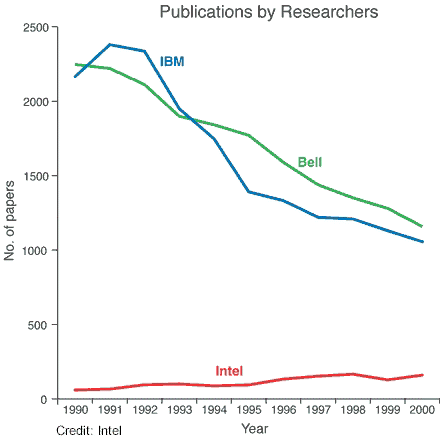 development
for the coming year. More recently Intel has defined its specific R&D commitment
for the year to be A$8.2 billion, nearly twice that of the Australian
Government. In addition it is slowly become more open in announcing just what it
is doing, thus joining IBM's research centres and Lucent Technologies' Bell
Labs. As of a year ago Bell Labs contributed over 1150 research publications and
IBM 1050. Intel's contribution was 165. On the other hand the number of
publications from Bell Labs and IBM have steadily declined since 1991 from over
2200, Intel's although still a long way to go is slowly increasing. As Robert
Service in his Science article of September 14th points out,
"At Intel, [Gordon] Moore and [Bob] Noyce opted against building a central
research lab. Instead, needed research would take place alongside teams
developing better and faster computer chips, a strategy the company still
follows today. The result was a far cry from the open-ended studies of the
cosmic microwave background and superconductors that won fame and Nobel prizes
for Bell Labs and IBM. Intel researchers haven't netted any Nobels, but it's
hard to argue that the company's strategy hasn't been a success. The company
still favors decentralized research linked to developing new products. But
according to numerous company officials, long-term research is increasingly
gaining favor."
development
for the coming year. More recently Intel has defined its specific R&D commitment
for the year to be A$8.2 billion, nearly twice that of the Australian
Government. In addition it is slowly become more open in announcing just what it
is doing, thus joining IBM's research centres and Lucent Technologies' Bell
Labs. As of a year ago Bell Labs contributed over 1150 research publications and
IBM 1050. Intel's contribution was 165. On the other hand the number of
publications from Bell Labs and IBM have steadily declined since 1991 from over
2200, Intel's although still a long way to go is slowly increasing. As Robert
Service in his Science article of September 14th points out,
"At Intel, [Gordon] Moore and [Bob] Noyce opted against building a central
research lab. Instead, needed research would take place alongside teams
developing better and faster computer chips, a strategy the company still
follows today. The result was a far cry from the open-ended studies of the
cosmic microwave background and superconductors that won fame and Nobel prizes
for Bell Labs and IBM. Intel researchers haven't netted any Nobels, but it's
hard to argue that the company's strategy hasn't been a success. The company
still favors decentralized research linked to developing new products. But
according to numerous company officials, long-term research is increasingly
gaining favor."
One of the problems that Intel is now facing is that current
methodologies for chip manufacture are coming close to hitting the wall and while
up until recently it could afford to avoid being a leader in R&D, relying on
existing technologies, that no longer looks to be the case and it's beginning to
put in some hard yards. But that's only a third of the equation, it's
critical for Intel to let other companies know what they're up to. "To get
others to follow, you have to tell people what you're doing," according to IBM's
Randy Isaac. "And if you can't get them to follow, you're not a leader, you're a
loner."
And the final third of the equation is publicity's role in
attracting new research talent and ideas to the company to drive home the
message that the company is a place where scientists' hard work will be valued.
IBM's Chris Murray puts it succinctly, "research is becoming more of a strategic
tool than it has been in the past."
It's true for Intel, it's true for IBM, and it's true for
Australia as a nation. The Government's penny pinching is eroding the
foundations of research in the nation and it's lopsided approach in apportioning
what it does grant exacerbates the problem.
![]() A Hard Look at What was and What
Might Have Been. (September 24, 2001)
A Hard Look at What was and What
Might Have Been. (September 24, 2001)
Not a day-and-a-half after the mass killing and destruction
in New York and Washington researchers got together in Boston for some hard
headed discussion. At the meeting some scientists expressed concern that a
rattled public may expect too much from them. "Technical solutions can't solve
the problem" of terrorism, says Harvard biologist Matthew Meselson, a member of
a 1998 NAS panel that examined U.S. responses to potential chemical and
biological terrorism. Many researchers want the Bush Administration to change
direction and lobby for stronger international controls on biological weapons
and greater bilateral cooperation with Russia. Adds Paul Josephson, a science
historian and nonproliferation expert at Colby College in Waterville, Maine,
"Joint and multilateral programs are the only hope for nonproliferation."
Like quarks in the nucleus weapons of mass terror come in
three flavors: nuclear, chemical and biological. Assessing them in
turn the consensus was:
1. constructing a nuclear fission weapon requires high-level expertise, substantial facilities, and lots of money--all three of which would be difficult, although not impossible, for a terrorist group to pull off without state support,
2. "Chemical weapons are really nasty to work with: You need organic chemists who know what they are doing," says Raymond Zalinskas, a former member of an Iraq weapons inspection team and now a researcher at the Monterey Institute of International Studies in San Francisco. "And there are technical issues with spraying." The 1995 nerve gas attack in the Tokyo subway, for example, injured thousands but killed only 12 people largely because sprayers clogged,
3. the most worrisome threat, according to many researchers, is biological. "Their potential for damage is much greater" than the chemical threat, says Harvard biochemist George Whitesides, who served on a Defense Science Board panel that examined the biological weapons. Among the most potent and potentially accessible agents are smallpox, anthrax, and plague.
Donald Henderson of Baltimore's Johns Hopkins
University Center for Civilian Biodefense Studies felt that terrorist could,
"handle a biological weapon." Others are not so sure. The likelihood that
terrorists could gain access to smallpox is extremely small, notes Zalinskas,
unless there are secret caches in countries like Iraq. Plague is very difficult
to handle, he adds, whereas anthrax dispersal poses complex technical hurdles.
What was seen as a very real scenario was that terrorists could carry out
potential mass destruction without sophisticated weaponry, by targeting U.S.
nuclear or chemical facilities using conventional bombs or hijacked aircraft.
Finally it was emphasised that better coordination and more
resources are not a magic bullet. "I don't see a shortage of money; I see a
shortage of ideas," said Harvard's Meselson. "And we're already spending
gigantic amounts to cure cancer and AIDS, so let's not exaggerate what more
money would do."
He and others emphasise that R&D to halt or cope with
attacks is no substitute for diplomacy to prevent them. That means stopping the
spread of the materials and expertise needed to develop such weapons.
![]() Mile High Laser Ranging Maps WTC
Ruins. (September 24, 2001)
Mile High Laser Ranging Maps WTC
Ruins. (September 24, 2001)
The
New York Times
reports that a specially equipped airplane using laser-based instrumentation and
high resolution global positioning equipment is allowing scientists to make
accurate topographic images of ground zero, in hopes that they can help firefighters and rescue workers navigate the mounds and chasms of debris and
identify areas that may shift or collapse as well a indicating where underground
fires are still burning. A resolution of 15 cm is being obtained.
![]() Whereto Now? (September 17, 2001)
Whereto Now? (September 17, 2001)
The catastrophic events in New York and Washington last week
show every sign of having far reaching and long term consequences for the United
States and, therefore, much of the rest of the world. The immediate allocation
of A$78 billion as a first instalment to allow President Bush to implement
"whatever it takes" to pursue the containment of terrorism presages that its
national priorities will change and it is not unlikely that the impact may be as
profound on the United States as that of the American Civil War.
There is a real danger that the reorientation of priorities
may degrade the institutions that are the foundations of a democracy. The
support of a nation's educational system and its freedom from coercion is
among the most vital, and there is the possibility that the methods chosen to
defend the system can lead to its unacceptable adulteration. The importance the
Bush administration places on that proposition remains to be seen; the
consequences will be profound and the aftershocks reverberate through many
decades for many nations.
![]() Feel a Need to Copyright Your DNA?
$2,900 May Allay Your Paranoia. (September 17, 2001)
Feel a Need to Copyright Your DNA?
$2,900 May Allay Your Paranoia. (September 17, 2001)
It's the sort of entrepreneurship that defines gimmick. Andre
Crump has set up the DNA Copyright Institute to, as his web site states, "to
address the uncertain issue of an individual's ownership of their [sic] own,
unique DNA Profile. Our objective is to insure that all citizens and their DNA
Profiles/Patterns are generally covered under existing Copyright [sic] laws,
preventing duplication in any form, now known or later developed." For this
altruistic objective Mr. Crump asks the modest fee of US$1,500.
However, beware, Science referring to a spokesperson
for the US copyright office points out, "Not quite: a person's DNA, he says, 'is
not an original work of authorship.'"
![]() US$20M to Upgrade Undergraduate
Science Teaching at Research Universities.
(September 17, 2001)
US$20M to Upgrade Undergraduate
Science Teaching at Research Universities.
(September 17, 2001)
 The Howard
Hughes Medical Institutes "has issued a challenge to science professors
across the United States: Show the same ingenuity in your undergraduate teaching
that you do in your scientific research." To that end HHMI has allotted
US$20 million (A$38¾ million). It stated,
"[We plan] to award $1 million each to 20 research scientists on the basis of
their plans to transmit the excitement and values of scientific research to
undergraduate education. Those selected will become "HHMI Professors" and
receive 4-year grants of $250,000 annually to apply their creativity and
enthusiasm to undergraduate teaching. HHMI has invited 84 research universities
to nominate tenured faculty members to compete for the grants, which it will
award in the fall of 2002."
The Howard
Hughes Medical Institutes "has issued a challenge to science professors
across the United States: Show the same ingenuity in your undergraduate teaching
that you do in your scientific research." To that end HHMI has allotted
US$20 million (A$38¾ million). It stated,
"[We plan] to award $1 million each to 20 research scientists on the basis of
their plans to transmit the excitement and values of scientific research to
undergraduate education. Those selected will become "HHMI Professors" and
receive 4-year grants of $250,000 annually to apply their creativity and
enthusiasm to undergraduate teaching. HHMI has invited 84 research universities
to nominate tenured faculty members to compete for the grants, which it will
award in the fall of 2002."
Thomas Cech, HHMI President explained why the challenge was issued.
"Research is advancing at a breathtaking pace, but many college students are
still learning science the same old way, by listening to lectures in large
classes and memorizing facts from textbooks. We wish to empower scientists at
research universities to become more involved and come up with really innovative
ideas that 'break the mold' and take a fresh look at science education." Clearly
HHMI although it is a biomedical research philanthropy has a broad vision.
Incidentally the list of 84 universities (see link above) makes interesting
reading, the majority of them are publicly funded.
And for those interested,
Sigma Xi
has an extensive list of sites addressing undergraduate science teaching matters
as well as some broader issues.
![]() Science and the Undergraduate.
(September 16, 2001)
Science and the Undergraduate.
(September 16, 2001)
The August 31st issue of Science has an
extended section (some 20 pages) on the teaching of science to undergraduates
and covers issues such as increasing hands on involvement for students, which is
to say more and more meaningful labs and less didactic lecturing, involving
undergrads in original research and the use of online teaching. It ought to be
required reading at the very least for ministers and shadow ministers and staffs
who have responsibility of science and/or education. For example the caveats and
benefits regarding online teaching get a good airing as does the experience of
Britain's Open University.
Importance is placed not only on science for prospective
scientists but also points to the study of science to assist non-scientists in
understanding science.
![]() David Hockney, if not a Polymath
Comes Reasonably Close.
(September 16, 2001)
David Hockney, if not a Polymath
Comes Reasonably Close.
(September 16, 2001)
 Hockney
best known as a pop artist painter and photographer, is an opera set designer,
having done a renowned setting for Mozart's Magic Flute, and is about to have
published his book Secret Knowledge; Rediscovering the Lost Techniques of the
Old Masters where with the assistance of physicist Charles Falco he details
his contention that the old masters used lens as copying aids to bring
verisimilitude to their art, particularly for matters such as perspective, and
that this was the case since the beginning of the 16th century. While
traditionalist critics take offence at such an iconoclastic view Rex Dalton in
his assessment (Nature 412:860 (2001)) gives a balanced account of
Hockney's thesis.
Hockney
best known as a pop artist painter and photographer, is an opera set designer,
having done a renowned setting for Mozart's Magic Flute, and is about to have
published his book Secret Knowledge; Rediscovering the Lost Techniques of the
Old Masters where with the assistance of physicist Charles Falco he details
his contention that the old masters used lens as copying aids to bring
verisimilitude to their art, particularly for matters such as perspective, and
that this was the case since the beginning of the 16th century. While
traditionalist critics take offence at such an iconoclastic view Rex Dalton in
his assessment (Nature 412:860 (2001)) gives a balanced account of
Hockney's thesis.
All goes to show that physics does have its uses. Now it's
just a matter of finding an obvious immediate benefit for parliamentarians.
![]() Mathematicians do it too.
(September 16, 2001)
Mathematicians do it too.
(September 16, 2001)
Having mentioned the Aspen Center for Physics the other day
as a "drop dead gorgeous" place it turns out that mathematicians in North
America look like getting into the act. In a couple of years they'll have a
retreat in the Canadian Rockies near
Banff. It'll be modeled on similar facilities in France and Germany.
It's about time Australia took advantage of its opposite
season status and go into the act, and were a multidisciplinary site set up it
could lead to highly imaginative science. Furthermore, it'd be a cheap way of
attracting top minds to interact with the locals as well as perhaps inducing
them to migrate if we can get some government sometime to rebuild from the mess
that's been made of our tertiary education system.
![]()
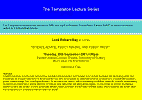 Robert
May Dropping in to Give a Talk. (September 10, 2001)
Robert
May Dropping in to Give a Talk. (September 10, 2001)
The Oxford Ecologist, immediate past Chief Scientific Advisor
to the UK Government, current President of the Royal Society, well known
authority on vertebrate hexapods
(Nature 264: 16-17 (1976)) and Sydney University graduate, Robert May,
will be giving the 2001 Templeton Lecture, "Science Advice, Policy Making and
Public Trust" at 6pm, Thursday September 20th in the Eastern Avenue
Lecture Theatre, University of Sydney (near the Carslaw Building, City Road
Entrance). Admission is free.
Abstract:
Scientific advances over the past century have resulted in improvement in most peoples' lives, in both developed and developing worlds. But increasingly we recognise that many of these benefits have been accompanied by unintended adverse consequences: unsustainable population growth; climate change; loss of biological diversity. As we start a new century, with ever-widening possibilities opened by scientific understanding, we need to do a better job of asking what kind of world we want, rather than just letting things happen. So how should we conduct the dialogue between science and society, or more specifically between "citizen scientists" and the many different publics whose questions and worries about the consequences of scientific advances need to be heard?
PS: Who says ecology
doesn't pay; Lord May of Oxford is a 2001 Blue Planet Prize winner "for
developing mathematical ecology and the fundamental tools for ecological
conservation planning," 50 million yen (~A$830,000).
![]() Journals Make a Good Start to Confine
Authors' Conflicts of Interest. (September 11, 2001)
Journals Make a Good Start to Confine
Authors' Conflicts of Interest. (September 11, 2001)
The worrisome matter of conflicts of interest arising when
scientific studies partially or wholly funded for example by pharmaceutical
firms or governmental agencies, which may have a vested interest in the
evaluation of the results, is beginning to be addressed by some important
publications.
First, Nature in its August 23rd editorial
set out its "Declaration of Financial Interests" to go into effect on October 1st.
One paragraph cogently sets out Nature's view, "It is difficult to
specify a threshold at which a financial interest becomes significant, although
we note that many US universities require faculty members to disclose interests
exceeding $10,000 or 5% equity in a company ... Any such figure is necessarily
arbitrary, however, so we offer as one possible practical alternative guideline:
'Any undeclared competing financial interests that could embarrass you were they
to become publicly known after your work was published.'"
Now eleven medical journals, including the Medical Journal of
Australia have stated that researchers in order to get their results
published will now have to guarantee that they, not industry or government
funders, controlled a study.
The
full
statement is available online and is signed by the editors of the following
journals:
Annals of Internal Medicine; Journal of the American Medical Association; New England Journal of Medicine; Canadian Medical Association Journal; Journal of the Norwegian Medical Association); The Lancet; MEDLINE/Index; New Zealand Medical Journal; Norwegian Medical Association; Dutch Journal of Medicine; Annals of Internal Medicine; The Medical Journal of Australia; and WJM Western Journal of Medicine.
![]() Our Relative Scientific Impact - Good
Enough? - Depends on Who/What You See as the Competition (September 5, 2001)
Our Relative Scientific Impact - Good
Enough? - Depends on Who/What You See as the Competition (September 5, 2001)
The Australian Research Council (ARC)
has an upbeat Web site together with a lot of useful information for prospective
grantees. In addition if you dig a bit you'll find a couple of interesting
charts which the
ARC has taken from the Department of Science, Industry and Resources'
publication Australian Science and Technology at a Glance, 2000.
The period closely covered
by the graphs (1992/93 -1996/97) saw an increase in GERD/GDP from 1.52% to
1.65%.
From 1996/97 - 2000/01 GERD/GDP decreased from 1.65% to
1.40%.
GERD = Gross Expenditure on Research and Development;
GDP = Gross Domestic Product.
Note that the citation impact is compared to world not EU or OECD
averages. We are not aware of more recent comparative analyses.
![]() Taking the Longer View.
(September 3, 2001)
Taking the Longer View.
(September 3, 2001)
Despite the Governmental hyperbole following the
announcement of the Innovation Action Plan (IAP) in
Backing Australia's Ability
it appears that compared to support for research and development in the EU
and leading OECD countries Australia is slipping further behind. It's just that
the slippage curve may not be quite as steep as it has been over the last half
decade. In the latest example of governments recognising the long term value of
scientific research, Japan's Prime Minister, Junichiro Koizumi announced last
month that although there would be an overall 10% budget reduction, guidelines
for the research budget recommended an A$18 billion boost for the coming year,
in short a +15% differential.
On a per capita basis the Australian Government would inject
an additional $2.7 billion for research in the coming financial year. The
whole of the IAP designates $2.9 billion over the next five years of which
$159 million will be allocated in 2001/02.
While Japan is in a severe economic downturn, the Federal
Treasurer, Peter Costello reminds us that the Australian economy is in excellent
shape. That being the case, wouldn't it be both wise and affordable to support
Australian research to the same per capita extent being proposed in Japan.
Despite Lleyton Hewitt somewhat
blotting his copybook the other day a fist pumping COMEON would
seem called for.
UPDATE (Sept. 5, 2001) The table below (published by Science Now) broadly
indicates the distribution of funds in US$.
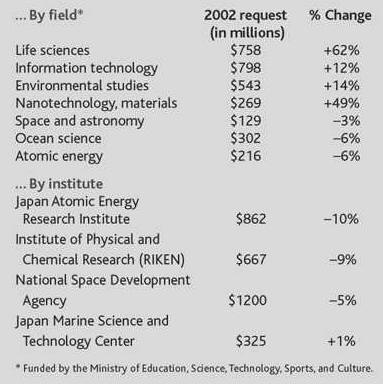
![]() For Nearly 40 Years it's Been a Place
Where Physicists Could Talk. (September 1, 2001)
For Nearly 40 Years it's Been a Place
Where Physicists Could Talk. (September 1, 2001)
In 1957,as a 25-year-old graduate student at Carnegie Mellon
in Pittsburgh, George Stranahan rented a house in Aspen for the summer, to fish and work on his
dissertation. The fishing was great but his work lagged, he realised,
because he missed the give and take with other scientists. The
Aspen Center for Physics opened its
doors in June 1962. Some of the more famous "alumni" - Philip Anderson, Hans
Bethe, James Cronin, Richard Feynman, William Fowler, Murray Gell-Mann, Leon
Lederman, Steven Weinberg and Kenneth Wilson. The summer and winter workshops
allow hundreds of physicists, astrophysicists and kindred types to get together
for the give and take that Stranahan (he did get his doctorate) missed.
"It's achieved an intellectual critical mass and it's in a drop-dead gorgeous
place," according to David Bishop, a physicist at Bell Labs. "The smartest
people in the world come here." The same sort of environment made Cold Spring
Harbor such a seminal environment for what eventually turned into molecular
genetics. The
New York Times story gives an overall picture but the Center's Web site is
well worth a visit. And there is no reason why a similar initiative, geared
toward the "enabling sciences" wouldn't be a world-wide attraction in Australia
taking advantage of our opposite seasons to the Northern hemisphere.
